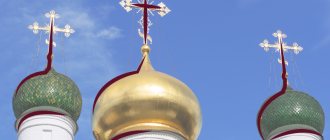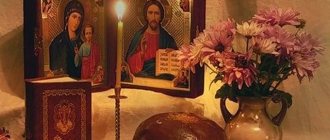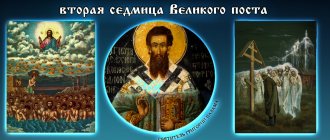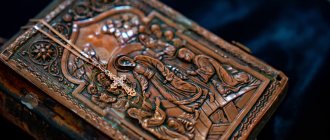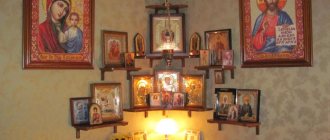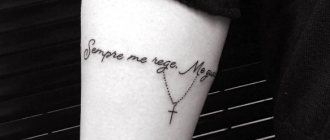author Mudrova Anna Yuryevna
Candle of prayer Burn, burn, candle of prayer, And flare up more and more, So that the nets of the devil's trap Do not carry away my soul. Burn, burn, candle of prayer! Glow, glow, lamp of the heart, With love for God growing stronger, Listen to the harmonies of the heavenly scherzos, Forgetting about the murmur of passions. Glow,
From the author's book
Ugreshskaya candle Ugresha, near Moscow, where I was lucky enough to be born and live, has an ancient and glorious history. The name “Ugresha” is about 2000 years old and comes from the Finno-Ugric name of the left tributary of Moscow - the river, which means “meadow river”. In the 7th century here
From the author's book
Candle from the Holy Sepulcher Many, many years ago, when Florence had just been proclaimed a republic, there lived a man named Raniero di Ranieri. He was the son of a gunsmith and although he knew his father’s trade, he was reluctant to engage in it. This Raniero was different
From the author's book
Church candle A church candle is a symbol of the prayer of a believer. By its burning in front of the icon, it shows the warmth of love for the Lord, the Mother of God or a saint, expresses a person’s desire for spiritual transformation, just as wax turns into fire. Since a candle
From the author's book
“The Goalkeeper” (“The Unquenchable Candle”) This same icon is sometimes called the Uglich icon, since it became famous in the Alekseevsky Monastery in the city of Uglich in 1894. On July 6 of this year, a St. Petersburg merchant arrived in Uglich, who had been suffering from a serious illness for a long time. The merchant told the abbot,
Orthodox churches are always quite dark. And this feature is not just a feature of church architecture. Twilight is a symbol of the life of a person immersed in sin and ignorance. And the light of revelation and faith in this case is symbolized by a lamp or candle installed in the church. The lamp is an image of the true light that is revealed to man in the Kingdom of God. It is for this reason that lamps are always lit in front of shrines.
The very first lamps were used by Christians to illuminate caves in which, hiding from persecution, they held secret services. As then, now they are vessels filled with a special oil - oil that heals the soul and body of the Orthodox.
The meaning of Orthodox lamps
Each lamp in Orthodoxy has its own meaning. It is enshrined in the Church Charter of Divine Services. Lamps, in particular, symbolize one of the saints who shine for Christians in the church darkness. In front of the icons, as a rule, a candle and a lamp are placed simultaneously. And if candles mean an offering, a gift to the Lord from humanity, then oil lamps symbolize the transformation of man under the influence of God's grace. Their light and warmth signify a person’s sincerity before God and are evidence of the purity of his thoughts and feelings.
Lamps are used even during the day, when the room or hall of the church is quite light. During the holidays, all lamps must be lit. During night services, with extremely poor lighting, lamps can be lit in very small quantities, for example, only in front of the priest reading the service, in front of individual icons: the Savior, the Mother of God, the temple icon. This is done in order to emphasize the defining moment of the service, its main purpose.
How to make a wick from cotton threads?
The thread for the candle core should be natural. Synthetic materials burn quickly, causing smoke, crackling and an unpleasant smell. Before choosing one thread or another, you need to set its tip on fire. If a hard ball forms on it and the thread melts, it means that we have synthetics.
Floss threads are ideal for making candles. They are soaked in one of the solutions, the recipes for which were given above. You can use another one: dissolve 1 tbsp in 1 glass of water. l. salt and 2 tbsp. l. boric acid, soak the wicks for 12 hours. Then they are dried for several days, twisted into flagella or braided. If you don’t want to make a wick, you can remove it from a household candle.
Why are lamps placed in front of the icon?
St. Nicholas of Serbia explained very precisely why lamps are installed in front of the icon. First of all, according to him, faith is light, and lamps remind us of the pure light with the help of which our Lord Jesus Christ warms and heals human souls. In addition, they are symbols of the bright character of the saints in front of whose faces they are installed. They also remind people of their sinful thoughts and actions, call us to the true path, call us to fulfill the commandments and do good deeds.
Lamps are that “small sacrifice” that a person can make to the Savior because He gave his life for him. During prayer, these lamps drive away the forces of evil. The light of the lamp encourages us to humility and sacrifice, reminds us that just as its fire cannot flare up without human participation, so without God our heart cannot flare up.
Alternative: wick made from bandage or braid
The medical bandage is made from natural threads, so it is suitable for making candle wicks. It is better to take a narrow bandage, which should be cut lengthwise. The length should match the height of the candle. The lower end of the bandage is tied in a knot, and the rest is twisted into a tourniquet. For wax candles, the flagellum is tightened slightly, for all others - tighter. After soaking in a flammable solution and drying completely, the wick can be installed in the center of the candle using a wire.
Braid is another material for the core of a homemade candle. For thin candles, it is also cut lengthwise; for thick ones, it is left as is (you should focus on the diameter of the candle). The lower end is either tied with a knot or attached to a wick holder.
What should it be
Quality is of utmost importance. And not only because it affects health in some way. By kindling it, we open our heart to God, which must be pure: there should be no anger, no resentment, no bad thoughts in it. Likewise, oil cannot be of poor quality, cheap, or unclean. The clergy believe that the use of low-quality oil is a sign of impoverishment of faith, a permissive attitude towards piety, and the perception of shrines exclusively as some kind of primitive attribute.
In the Christian faith, many objects carry great meaning. The lamp is no exception. This is a symbol of a person’s unquenchable faith in God. In addition, a lamp burning in a house in front of the icons means that a guardian angel is protecting this house and is in place. Living fire has entered the lives of believers so tightly that it is difficult to imagine a church without the flickering flame of candles and lamps.
Making a wooden wick
When burning, a wooden wick produces a crackling sound, like a fire, and a light woody aroma. If you decide to make a wick yourself, you should know that only deciduous trees are suitable for this. A stick approximately equal to the length of the candle is cut out of the raw material and dried well. After this, it is soaked in olive oil (sunflower oil can smoke) for 20 minutes, turning occasionally. After the time has passed, the stick is removed from the oil, wiped dry and placed in a glass in a vertical position. When the wick is completely dry, you can insert it into the candle.
Make a wick simply from toothpicks (for small candles), canapé skewers (for medium ones), skewers or Japanese sushi sticks (for large candles). They should also be pre-impregnated with oil or a special solution.
The dried wick is placed in a candlestick, poured with melted paraffin or wax and waited for it to “set”. You can add dye to the base in advance. Lovers of coffee aroma can decorate a candle with coffee beans. This should be done at the last stage of hardening of the mass so that the grains do not drown.
An invariable church attribute is the lamp, which, like candles, is lit near holy images. In the temple, lamps burn continuously, and houses are lit mainly during the reading of prayers or on major temple holidays.
The lamp is a symbol of God's unquenchable fire, which continuously burns in a person. That is why in temples they keep the fire burning continuously in front of the images.
Story
The first lamps are primarily lamps. The word itself is of Greek origin. The literal translation is “a lamp burning before the saints.” Initially, they were actually used for lighting in dark caves by the first Christians. There they held their services, hiding from possible pursuers.
Gradually, lamps became the most important detail of the decoration of the temple and an attribute of some church rituals. The premises of almost any church are quite light during the day, but it is impossible to find a building without burning candles or lamps. This evokes in the souls of believers a certain mood for communication with the Almighty. It doesn’t matter for what purpose you visit the temple: to pray for health or peace of soul, to repent or to thank God. Anyone who enters here will definitely light a candle, a symbol of faith in God.
Meaning
There are no random things in churches; every object carries its own meaning. The light of a candle in a bronze candlestick or lamp is a unique symbol of prayer. In household use, a burning lamp is seen as the presence of God's Law in the house.
The lamp, located directly in front of the icons, is nothing more than an expression of sincere gratitude to the saints for their sacrifice. They gave their lives to save and forgive the sins of others.
You can often see burning lights in a cemetery. They are usually lit on the first, third, ninth and fortieth day after the funeral. This is a kind of request for mercy and forgiveness of the sins of the deceased before God. Many people bring lamps when they visit their loved ones in this place of sorrow.
Features of special candlesticks on graves
The candlestick in the cemetery regulates the strength of the fire. He doesn't let it fade or get too hot. This property is determined by the materials, shape, and configuration of the elements.
For funeral rituals, budget plastic lamps are purchased at graves. They consist of a translucent container, a tin lid, and a candle. They have positive and negative characteristics:
| Advantages | Flaws |
| Low price | Primitive design |
| Easy to move | Poor stability of the lamp |
| Burning time at the grave is up to 8 hours | For one time use only |
| Maintenance free | Possible fire |
| Availability | Possible burns |
Versions with glass containers of different colors are similar. They can be filled with liquid oil instead of paraffin or wax.
The decorated grave will be complemented by a permanent reusable lamp. The product has a high price and workmanship. You can choose materials, sizes, and unique decorative elements.
Advantages and disadvantages:
| Advantages | Flaws |
| Reliability | High price |
| Sustainability | Installation space required |
| High quality | Installation required |
| Natural materials | Requires maintenance |
The shape of the standard model is a hexagon or cylinder with a dome-shaped lid with a cross.
Popular stationary lamps for placement on a grave are made of stone, metal, glass (combinations thereof). Granite and gabbro make neat structures on an open grave. The disadvantage is that they do not protect the flame from wind and precipitation.
Device
Essentially, a lamp is an improved candle. One option is a container with paraffin, usually a glass (crystal) cup, on a stand. Reusable use is ensured by simple replacement of flammable material. This is typical for desktop products. The stand is metal with a border and figured legs, often decorated with faith. Replaceable cups, different colors:
- red - for Easter time;
- green - for daily use;
- blue, purple or colorless - for Lent.
Supplied with wicks. They can be of different designs:
- A thin plate with a small hole in the middle for a wick. It is placed on the surface of the oil, one end of the wick is above the plate (the length of no more than one or two match heads), the second is lowered into the oil.
- The Greek design is a cork float with a solid wick stuck through it.
The operating principle is the same. The design provides the most comfortable conditions for long-lasting flame maintenance. Wide short candles are used in lamps for religious processions. They are inserted into an oblong-shaped vessel, closed on top with a tin lid with holes. This shape allows the flame to burn long and evenly.
What is a lamp
This is a special vessel in which lamp oil is poured. It is placed in front of the icon at home and in the temple.
The lamp consists of:
- plastic or glass vessel;
- wick;
- float;
- cup holder
There are several types of lamps:
- Wall-mounted. They are hung with a chain on the wall in front of the icon.
- With stand. They are placed on the floor in the temple.
- Seven-branched candlestick. Seven lamps, called the seven-branched candlestick, stand on the Throne in the altar. Arranged by a ladder.
- Lamp-lantern. Used at religious processions. There are small lamps that parishioners carry during the procession, and there is a large lamp-lantern in a special case with a long handle, which is carried by altar servers during the procession.
- Homemade. Placed on a shelf in front of the home iconostasis.
They all look different, but their essence is the same - a burning wick. Church lamps are beautifully decorated with metal carvings and gilding. The seven-branched candlesticks look especially beautiful.
Kinds
Products can be divided into several types. It depends on the size, place of use and location:
- hanging or church lamps are used exclusively in temples or churches;
- wall;
- desktop;
- extinguishable;
- inextinguishable - placed in front of icons, relics of saints, any especially revered shrine, they must maintain continuous combustion;
- for a religious procession;
- for household use.
The size depends on the volume of oil that can be poured into the lamp. Large ones are considered to be those with a volume of 100 to 500 milliliters. These usually illuminate icons in temples or churches. At home, small ones with a volume of 30-50 ml have proven themselves to be excellent.
A hanging lamp is not used in everyday life; it is more of a ritual object that plays an important role in the Orthodox faith. It is used at baptisms, burials, weddings, processions. Made from brass, copper, cupronickel, silver.
There are large chandeliers. They represent a massive church chandelier with many lit lamps and candles. It is customary to light them on holidays. The chandelier is located in the center of the building and looks very solemn. Often decorated with crystal pendants in which the reflections of candles are refracted. Some specimens can be compared to a work of art.
What can you use to make a homemade wick?
The easiest way is to buy a skein of ready-made wicks in a store or online. Cotton threads, wooden skewers, pieces of fabric and improvised means such as braid or medical bandage, gauze are suitable for making homemade wicks.
In order for a candle to burn, the wick must be soaked. To prepare the impregnating solution, use the following ingredients:
- 0.5 l of water;
- 5 g ammonium chloride;
- 5 g sodium nitrate;
- 5 g calcium chloride;
- 10 g borax.
All components are mixed, after which the prepared wicks are soaked for at least 15 minutes, then hung to dry (this takes about 5 days). The composition of the solution can be modified by making it from 700 ml of water mixed with ammonium chloride and sodium nitrate (1 g each). It is also possible to use a mixture of slaked lime (30 g), sodium nitrate (8 g) and water (0.5 l).
Some needlewomen prefer components that are more commonly used in everyday life. For 1.5 liters of filtered heated water take 2 tbsp. l. table salt without additives and 4 tbsp. l. Boers. Stir the ingredients well until a homogeneous mass is formed and begin soaking.
If you need to prepare wicks for future use, it is recommended to use regular newspaper to store them. You can also, after completely drying, dip each of them three times into molten wax, then dry again until the latter completely hardens.
Oil
Real oil for lamps is wood. This is the name given to a product obtained from the fruits of olives growing on a tree, and not from herbs or seeds. Spruce is considered the purest and highest quality oil of the highest grade. When burning, it does not form soot and does not emit any harmful substances.
Due to its purity and healing properties, oil is used both for anointing the sick and in baptismal rites. Throughout the thousand-year history of Christianity, olive oil was considered a worthy sacrifice to God.
What properties should a candle wick have?
Wicks are made from different materials, each of them has certain requirements. The wick is the central element of the candle that makes it burn. It determines how long and efficiently the candle will burn and whether it will smoke. When choosing a wick, it is recommended to take into account the diameter of the candle. Thin (up to 3 cm) correspond to thin wicks, candles with a diameter of 3–7 cm - medium, and wide (from 7 cm) - thick. If we “translate” this into the number of threads, then 15 twisted floss threads are suitable for the smallest candles in diameter, 24 for medium ones, and more than 30 for large ones.
When creating wax candles, it is advisable to use loose-weave wicks made from cotton thread, which burns slowly. If the candle is made not from wax, but from some other material, the wick must be tightly woven, since the viscosity of the candle mass during melting will differ. Wax is the thickest material.
Why do they light a lamp?
A bronze candlestick near an icon may well become an alternative to a lamp. The essence of the burning flame is important:
- the fire itself is a symbol of the annual miracle of the descent of the Holy Fire;
- it is a symbol of faith;
- the burning fire in front of the icon is the memory of the saints, the sons of light;
- fire encourages sacrifice;
- light cleanses from sins and dark thoughts.
According to church laws, lighting a lamp is possible only from a church candle.
WHY IS A LAMP LIGHTED IN FRONT OF AN ICON?
Lamp
(
Greek “lamp”
) is an oil-filled lamp lit in front of the icons, on the throne and the seven-branched candlestick. The symbolic meaning of the lamp is the eternal flame of faith in Christ, dispelling the darkness of evil and unbelief. In the homes of Orthodox Christians, it is customary to hang or place lamps on a stand in front of icons. This is an ancient pious tradition that symbolizes the constant prayer of Christians to God. If there is no lamp in the house, then this house is, as it were, spiritually blind, dark, and the Name of God is not always glorified here.
Even in the Old Testament it is written: “And the Lord said to Moses... that the lamp should burn continually; outside the veil of the ark of the testimony in the tabernacle of meeting, Aaron (and his sons) must set it up before the Lord from evening to morning always; this is an everlasting statute throughout your generations; They shall always set up their lamps before the Lord on a clean candlestick.”
(Lev. 24:1-4).
Modern ascetics say that a lit lamp cleanses the air of all filth and then grace reigns in the house. In no case should you use the fire from a lamp for domestic purposes - this is disrespectful to the shrine. It is not customary to light a lamp with a match; a church candle is used for this. They used to say about irreverent monks in monasteries: “He lights a lamp with a match...”.
The lamp light does not need to burn very strongly and smoke; it is enough for it to be the size of one or two match heads.
For the lamp they use lamp oil (originally olive oil), which can be bought in a church shop in any church.
The lamp can only be lit from a candle, with prayer and reverence. There is a special prayer read when the lamp is lit: “Light up, Lord, the extinguished lamp of my soul with the light of virtue and enlighten me, Your creation, Creator and Benefactor, for You are the immaterial Light of the world, accept this material offering: light and fire, and reward me inner light to the mind and fire to the heart. Amen".
Saint Nicholas of Serbia wrote the following about why we light lamps:
Firstly, because our faith is light
.
Christ said: “I am the light of the world”
(John 8:12).
The light of the lamp reminds us of the light with which the Savior illuminates our souls.
Secondly, in order to remind us of the bright character of the saint, in front of whose icon we light a lamp.
For the saints are called “sons of light” (John 12:36).
Thirdly, in order to serve as a reproach to us for our dark deeds, evil thoughts and desires, and in order to call us onto the path of the gospel light, so that we would be more zealous about fulfilling the commandment of the Savior: “Let your light so shine.” before people, so that they can see your good deeds"
(Matt. 5:16).
Fourthly, so that she becomes our small sacrifice to the Lord
, Who sacrificed all of Himself for us,
a small sign of great gratitude and our bright love
for the One from whom in our prayers we ask for life, health and salvation - all that only boundless Heavenly Love can give.
Fifthly, to frighten the forces of evil that sometimes attack us during prayer, diverting our thoughts from the Creator
. For the forces of evil love darkness and tremble at light, especially that which serves God and His saints.
Sixth, to encourage us to sacrifice. Just as oil and wick burn in a lamp
, submissive to our will,
let our souls also burn with the flame of love, submissive to the will of God in all suffering.
Seventhly, to remind us that just as a lamp cannot light up without our hand, so our heart, this inner lamp of ours, cannot light up without the holy fire of Divine grace, even if it is filled with all virtue. For our virtues are fuel that the Lord ignites with His fire.
Church of the Life-Giving Trinity on Sparrow Hills
What is a lamp
This is a special vessel in which lamp oil is poured. It is placed in front of the icon at home and in the temple.
The lamp consists of:
- plastic or glass vessel;
- wick;
- float;
- cup holder
There are several types of lamps:
- Wall-mounted. They are hung with a chain on the wall in front of the icon.
- With stand. They are placed on the floor in the temple.
- Seven-branched candlestick. Seven lamps, called the seven-branched candlestick, stand on the Throne in the altar. Arranged by a ladder.
- Lamp-lantern. Used at religious processions. There are small lamps that parishioners carry during the procession, and there is a large lamp-lantern in a special case with a long handle, which is carried by altar servers during the procession.
- Homemade. Placed on a shelf in front of the home iconostasis.
They all look different, but their essence is the same - a burning wick. Church lamps are beautifully decorated with metal carvings and gilding. The seven-branched candlesticks look especially beautiful.
How and why do you light a lamp and burn incense at home?
Content
Priest Andrei Chizhenko explains.
According to Orthodox doctrine, man is a two-part being: spiritual and physical. The soul is the image and likeness of God in man. Through the body, a person connects with the material animal world. This is the great task of man. To deify oneself (that is, to begin the path of ascent to God, the path of knowing Him, uniting with Him, or rather, with Divine uncreated energies) and through deification to deify and sanctify the rest of material nature, since man is its center and king. It seems to exist at the intersection of two worlds - spiritual and material. Based on this, the human body is a collaborator with the soul in the matter of salvation. It is the essence of the temple of God. This is why Orthodoxy treats the body so carefully. This can be seen from the burial order.
Therefore, all Church Sacraments and, as a consequence, divine services also have a dual nature. Example: in the Sacrament of Baptism, the priest invokes the name of the Holy Trinity - this is the spiritual main component. But the substance of baptism is completely material – water. Sacrament of Communion. Its core is the Body and Blood of Christ. And the substances for the Sacrament are prosphora, wine, water. Therefore, Orthodox worship influences the grace of the Holy Spirit not only on the soul, but also on the body. Anointing oil (touch), ringing bells, singing (hearing), icons, painting (sight), prosphora, Epiphany water (taste), burning incense (smell).
The family is a small church. This is also a kind of service to God and one’s neighbors. Naturally, we want God’s grace to sanctify ourselves and our homes, to protect us from all evil and defilement. In addition, in paradise the righteous and holy angels are in continuous worship - the praise of the Almighty. Therefore, with God’s help, we try to continue church services (within reasonable limits, of course) at home. Similar to this is the monastic rite of panagia (from Greek - “all-holy”), when the Mother of God prosphora, from which a piece is taken out in honor of the Virgin Mary at the proskomedia after the Liturgy, the monks solemnly transfer from the temple to the refectory, where they eat it with certain prayers, and then begin meal. Thus, the Liturgy seems to continue, and it continues in the cell conditions of monastic dormitories. In a spiritual sense, approximately the same thing happens to us when we seem to “bring the temple and worship home,” arranging from our lives a worship service, a sacrifice to the Almighty. That’s why, for example, earlier in every Orthodox home there was a “red” (beautiful from outdated) corner where icons were placed, incense was burned, and a lamp was lit. Often it was made to the east, like the altar of a temple. As a matter of fact, the red corner is a kind of home altar. In general, this is a very good tradition. Correct. The family makes a feasible sacrifice to God and arranges a dwelling for Him in their house, and He, of course, settles in it, because the loving hearts of His children long for a meeting with their Heavenly Father.
It is not always possible, of course, to arrange a red corner to the east in modern conditions, but, in principle, every family can do it. This is our expression of love for God. The only thing I would like to say about this from experience... It is still necessary to SEPARATE a place in the house for the images of saints, so to speak, to clear it of other worldly things. Otherwise, you often see in houses how icons are filled with glasses or other completely worldly things. Sometimes other involuntary sacrilegious acts occur when icons are placed together with the increasingly popular Japanese netsuke gods, various “money toads” that “bring” wealth and success, or erotic paintings. Of course, this is unacceptable. A person must understand himself, Whom he serves: Christ or Belial. It is better to throw away or burn pagan idols and not keep them at home.
As for the lamp, for example, for me it burns constantly for days. Let us remember the parable of the ten virgins (see Matt. 25:1–13). In my opinion, a burning lamp, caring for it, buying lamp oil, candles for lighting it is our feasible sacrifice to Christ (a kind of tactile prayer to God) and a feasible financial sacrifice to the Church (lamp oil, candles, wicks, the lamp itself). Some people light a lamp before prayer. This is also good and beneficial. God will accept any sacrifice feasible for a person if it is made with reverence and a loving heart. The lamp, of course, is lit in front of the icons.
From my experience I will say that for a lamp it is better to take purified specialized lamp oil. No matter how much I tried to use regular sunflower oil and even refined sunflower oil, it burned poorly, the lamp smoked and became clogged.
As for incense - incense and incense, it is also quite possible to use it at home. You just need to not imitate censing by a clergyman in the temple (this is still the prerogative of the priest), but rather burn incense rather than burn incense with it.
Now in church shops there is a very large selection of both incense and censers. There are special “spiders” - light metal structures that are attached to the lamp. There is a platform on top of them. Incense is placed on it. From the warmth of the lamp fire, the metal heats up - and the incense begins to smell fragrant. There are special stationary censers - clay, porcelain, metal. They need coal. It is lit, placed in a censer, and pieces of incense are placed on top. The lid of this censer has special holes for smoke. You can light censers before prayer, you can walk through the house with the Jesus Prayer or any other prayer, filling its rooms with a heartfelt appeal to God, which rises into the sky as easily as smoke from a censer.
Burnt coals should be disposed of as follows. If you live in a private house, it is advisable to make a hole in clean soil in the front yard or garden, perhaps under a tree or bush, where you can shake out the ashes (including incense) from burning consecrated things. You can throw ashes into running water or into a river. If you live in an apartment, then it is also advisable to burn the remains of consecrated things somewhere in the park or in flower beds, then bury the ashes in clean soil. You can shake out the remains of burnt coal into flowerpots with indoor plants.
What I would like to warn against.
There is no need to turn your entire house into a church. It is important to understand that you should not only pray in the house, but also live. One or two or three places in the house allocated for spiritual needs are enough. Leave space in your home for yourself, your spouse, and your children. Everything is good in moderation.
The opinion of the portal's editors may not coincide with the point of view of the authors of publications.
Use of site materials in printed publications and on Internet resources is possible only with a link to the portal.
Olga
In a broad sense, a “lamp” is an oil-filled lamp lit in front of icons or on top of large stationary candlesticks. The symbolic meaning of the lamp is the eternal flame of faith in Christ, dispelling the darkness of evil and unbelief.
There can be either one lamp or more in the house. There is a pious tradition of lighting unquenchable lamps in houses, which burn both at night and when the owners are not at home. But in modern conditions this is not always possible or desirable, as it can become a temptation for non-believers or family members of little faith. Most often, a Christian lights a lamp when he comes home and does not turn it off until he leaves home. If there are no lamps, church candles are lit during prayer.
There is a special prayer read when the lamp is lit: “Light up, Lord, the extinguished lamp of my soul with the light of virtue and enlighten me, Your creation, Creator and Benefactor, for You are the immaterial Light of the world, accept this material offering: light and fire, and reward me inner light to the mind and fire to the heart. Amen".
Purpose of the lamp
A burning lamp represents a person’s heart burning with prayer and faith. The first mention of them is found in the Old Testament. They stood in the Tabernacle of the Covenant, where there was an Ark with the most expensive objects reminiscent of the miracles of God (a vessel with manna from heaven, Aaron's rod that blossomed, etc.) The Jews were very reverent towards the Tabernacle, as well as everything that was connected with it . Therefore, lamps were sacred things for them.
Nowadays, the lamp has more of a household character. Some people prefer to have them at home, but rarely light them, not seeing much point in it. And some believers do without them altogether.
Prayer for lighting a lamp at home
How often should you light a lamp at home?
Lamp in the house
In the homes of Orthodox Christians, it is customary to hang or place lamps on a stand in front of icons. This is an ancient pious tradition that symbolizes the constant prayer of Christians to God. If there is no lamp in the house, then this house is, as it were, spiritually blind, dark, and the Name of God is not always glorified here.
There can be either one lamp or more in the house. There is a pious tradition of lighting unquenchable lamps in houses, which burn both at night and when the owners are not at home. But in modern conditions this is not always possible or desirable, as it can become a temptation for non-believers or family members of little faith. Most often, a Christian lights a lamp when he comes home and does not turn it off until he leaves home. If there are no lamps, church candles are lit during prayer.
Modern ascetics say that a lit lamp cleanses the air of all filth and then...
With rosary beads – don’t rush!
This is not for beginners, but for already successful Christians.
But everyone should know what a rosary is.
This is not just a “counter” of prayers, but a spiritual weapon, a spiritual
a sword, and one must learn to use this weapon.
But everything has its time...
One monk said that there is nothing more precious to him than a rosary.
For in them every knot is connected with the Name of the Sweetest Jesus.
It is convenient to say prayers using the rosary: 30, 50, 100
Most often, the Jesus Prayer is recited using the rosary (“Lord
Jesus Christ, Son of God, have mercy on me a sinner"), but to this
It is better to begin prayer with the blessing of your confessor.
He will determine the number of prayers for the day.
They also read “Rejoice to the Virgin Mary” using the rosary, and sometimes “Our Father”.
The rosary helps you concentrate in prayer and not get distracted.
Home ‹ Questions for the priest ‹ Using a lamp
Using a lamp
Hello, Father Andrey!
Today I bought a lamp, a wick, a partition (I don’t know what it’s called correctly), lamp oil and incense. They didn’t really explain anything to me in the church shop, so I had questions:
1) How to light a lamp correctly? (As I understand it, you need to pour oil into the lamp, insert the wick into the partition. Place the partition on the lamp and light it, and drop some incense there (into the oil), right?)
2) How to insert the wick into the partition? This turns out to be a problem. The hole in the septum is thin and the wick is thick. Divide the wick into 2 parts?
3) Is it possible to make the wick yourself? How?
4) How often should the lamp be lit?
5) How does lighting a lamp differ from lighting candles?
6) I learned that the lamp needs to be lit from a candle, why? Thank you.
Saint Nicholas of Serbia wrote the following about why we light lamps:
1. Firstly, because our faith is light. Christ said, “I am the light of the world” (John 8:12). The light of the lamp reminds us of the light with which the Savior illuminates our souls.
2.Secondly, in order to remind us of the bright character of the saint, in front of whose icon we light a lamp. For the saints are called sons of light" (John 12:36)
3. Thirdly, in order to serve as a reproach to us for our dark deeds, evil thoughts and desires, and in order to call us onto the path of the gospel light, so that we would be more zealous about fulfilling the commandment of the Savior: So let your light shine before men, so that they may see your good works.” (Mt 5:16)
4. Fourthly, so that it becomes our small sacrifice to the Lord, who sacrificed all of Himself for us, a small sign of our great gratitude and bright love for him.
The icon illuminates the house. A room without images is like without windows. How to decorate your home with holy images? What should you know and remember? Let's try to figure it out at least a little.
Previously, every Russian hut had a red corner in which icons were placed. From the 16th century A most interesting monument of written culture has been preserved - the book “Domostroy”. This book is a collection of rules and advice concerning all aspects of family life. What does it say about the icons in the house (the text is literary edited, a little closer to modern language):
How to decorate your house with holy images and keep your temple clean
In every Christian’s home, in every temple (room), the holy and honorable images painted on icons should be placed on the walls, arranging a splendid place with all sorts of decorations and lamps, in which candles are lit in front of the holy images at every praise of God: and after singing they are extinguished and closed with a veil - not for any reason.
Actually, not everyone needs to light a lamp. As far as I know, the lamp at the home icon is used only by true believers (self-called Orthodox) Christians. Catholics sometimes light only candles during prayer, while Protestants do not use icons at all, following God’s commandment about the inadmissibility of different images.
But let's return to our ram. Both my grandmothers were original Orthodox Christians. So, the lamps in front of their icons were constantly burning. And they added oil to them, trying not to put out the fire.
And I see the point in such a tradition. In ancient times, there were no matches; making fire using other methods was not entirely convenient. And here fire is always at hand. You could always light something with it. Moreover, not just fire, but God’s fire. This is my version of the origin of such a tradition - a lamp near an icon. I don't claim the absolute truth.
Therefore, my answer: The lamp at home should not be lit at any specific frequency. She must.
Many people have a lamp, a small lamp lit in front of icons, but not everyone knows what symbolism the lamp is endowed with and what the lamp represents in Christianity. The word lamp itself has Greek roots and literally means a lamp before the saints. In the traditional rites of Orthodoxy, the lamp is used most often at baptism; it is an attribute of weddings and burials and symbolizes the eternal union of man and the church (God). As for burial, the lamp will be needed in the cemetery. It is lit on the first day of the funeral, as well as on the 3rd, 9th, and 40th days after. The lamp also burns on the anniversary of his death, on the anniversary of his death, and on the feast of Trinity.
The lamp is a symbol of fervent prayer to the Lord and a request for mercy for the deceased and the repose of his soul. People resort to the fire of lamps when they pray for forgiveness of all the sins of the deceased. The lamp is also the personification of the divine fire that descended on the apostles of the church. Sometimes provided in cemeteries (Exodus 30:8)
A candle is a small lamp, a source of radiant light. The separation of light from darkness was one of the first acts of creation. At the end of time, when the history of salvation ends, God Himself will be the Light (Rev. 21:23) of the new creation (21:5). Therefore, the theme of light runs through all of Holy Scripture, and specially made lamps from the very beginning of Old Testament worship became a necessary accessory to the tabernacle, and later to the Jerusalem temple.
The lamp, first of all, was a symbol of the presence of God. You, Lord, are my lamp; The Lord enlightens my darkness (2 Samuel 22:29). The light of a lamp or candle also symbolizes a bright, joyful and warm prayer to God. The light of the righteous burns cheerfully, but the lamp of the wicked goes out (Prov. 13:9). In Old Testament times, small vessels with olive oil and a flax wick were used as lamps.
To search, enter the word:
Number of entries: 16441
Hello! I was baptized last month and this weekend I have my first confession. I'm very worried because I don't know what to do. How is confession going? What should you do in front of the icon and the priest? What to say before repenting?
Dear Maria! Look into your conscience, it will tell you what sins to name. There is no need to look for special phrases. When you approach, cross yourself, say hello, and name your sins. You can preface your confession with the word: “I repent.” After confession, the priest reads a prayer of permission, placing the epitrachelion on the head of the penitent. Therefore, it’s good to bow your head when you say everything. Don't worry - while you wait your turn, you will see everything. God bless you.
Priest Sergius Osipov
Hello, I would like to thank Father Sergiy Osipov for answering my question.
- Lamp. - Lamp oil. - Church candle. – Matches or lighter. – Gauze or cotton cloth.
Buy lamp oil and wick in a special church store or in a shop at a temple. If there are none in the neighborhood, then you can make the wick yourself. Cut a piece of bandage or other cotton fabric. Twist it tightly into a bundle and insert it into the float of the lamp. Instead of special lamp oil, you can use olive oil.
Now some believers light lamps from whatever is at hand. But previously it was believed that a lamp should not be lit directly from a match, but that it was necessary to use a church candle, which is always available in an Orthodox home. You can buy candles in the same church store. A candle can be lit with either a match or a lighter. Do this and say the Lord's Prayer.
Light a lamp from the candle. There is a special prayer for this occasion: “Light up, O Lord, the extinguished lamp.
Why can't you light a candle from another candle in church?
People go to church to cleanse their thoughts and souls. There they receive peace from being in a holy place.
But there is a category of people who even come here to throw their misfortunes and problems onto others, and to spoil the more successful ones. Whether one can agree with this or not is a purely personal matter.
No matter how outrageous and absurd it may sound, you can also run into a witch or energy vampire in a church. At least that's what many people say. There are many superstitions about this. We will tell you about the possible behavior of witches so that you can protect yourself and your loved ones from possible misfortunes.
This article is purely for informational purposes, and you should not take this information too seriously, because the facts of the existence of evil spirits cannot be proven.
But some people claim that they became victims of sorcerers in this way, so we decided to pay attention to this issue. After all, forewarned is forearmed
How to behave in church
In order to feel confident in church and know how to behave correctly in this place, what and when to do, we advise you to consult with the priest, and not with local grandmothers. In the meantime, we'll tell you what "people are talking about."
Before entering the church, you can give alms to beggars, while saying to yourself: “Let the hand of the giver never fail.” When you leave, you shouldn’t do this, because along with the money you give away what you came for, what you asked from the Lord and the saints.
They say that it is possible to recognize witches and sorcerers by certain signs
While in a church or surrounding area, pay attention to the people standing around you
Witches and sorcerers try to cross their fingers or their hands themselves so that the left hand rests on the right hand. In the temple they stand in such a way that their back is always covered from the altar. And they try to leave the church as slowly as possible and with their backs.
Another important point: in church they can walk around you counterclockwise and poke you with their hand, then stand behind you to drain your energy. If this happens, then immediately, without hesitation, touch this person with your left hand so that the damage goes back.
Also, special attention should be paid to candles, because it is with their help that witches often perform their rituals. There are many superstitions about this, which we will tell you about.
How to use church candles correctly
Many beginners do not know where to put a lit candle. A witch or sorcerer will definitely try to approach such a person with advice. A person is told: “Light the candle and leave the church backwards.” If you do this, you will damage yourself.
In a temple, it is not advisable to light a candle from matches or a lighter, but from a lamp that burns in the center. Under no circumstances should you light your candle from those standing next to you, so as not to drag other people’s problems onto yourself. Also, do not let others set fire to yours, so that they do not take away your happiness.
Do not move away from your candle, which you placed for good, until more than half of it burns out. Because they can simply remove it and put in another one.
Put out the candle yourself and do it with your fingers rather than blowing it out.
Pay attention to this moment: you lit a candle, walked away from it, and it suddenly became smokey. Don't be lazy and look at your feet
You can stand on a damn needle. But if you look at things realistically, then the reason for this may simply be a low-quality wick.
And finally. The following situation may arise: you are walking down the street near a church, and a sweet granny comes up to you and asks you to count the number of domes.
Do not do that! They say that near a one-domed Orthodox church they spread loneliness, near a three-domed one they spread anxiety, fears, problems with the law, and near a five-domed one they spread various illnesses.
This does not mean at all that you need to bypass the church. On the contrary, come to this place as soon as you have such an inner desire. Just know that not all people have good intentions, but such is life, and this should not be an obstacle to any of your actions.
PS Take note of these tips, maybe someday they will be able to help you. And don’t forget to share interesting information with your friends on social networks! In contact with
